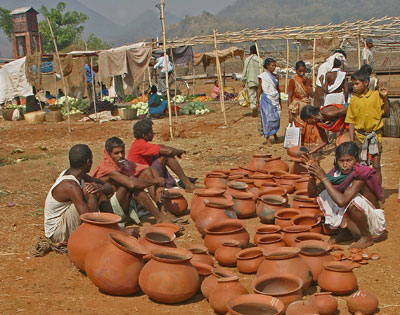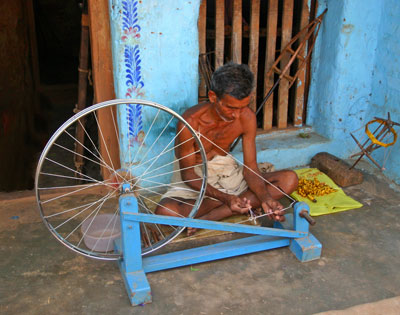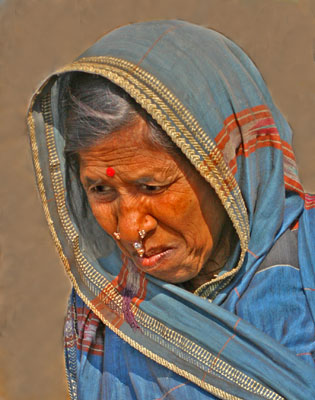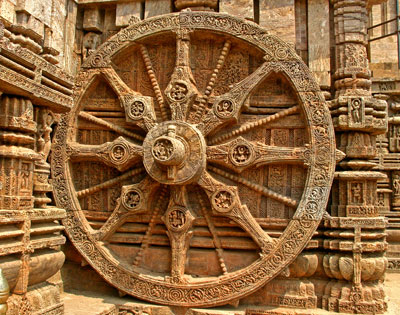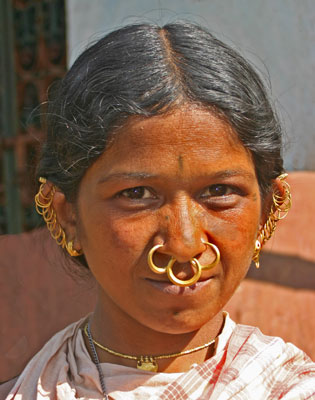Orissa – a private tour in tribal India
by Joyce Bruck, Ocean Ridge, FL
My excursion to Orissa, India, in March ’08 came as kind of an accident. My original destination was Bhutan, where I was going to attend the Paro Festival. Usually I plan my own vacations through the Internet, but the government of Bhutan has many restrictions, effectively requiring visitors to use a travel agent for assistance.
During the planning process I decided that, since I was going halfway around the world, I should extend my trip with a visit to another place nearby. As I searched for options, I came across a company called Spirit of India (Mill Valley, CA; 888/367-6147, www.spirit-of-india.com) that specializes in exotic destinations all over the world.
The company’s brochures included four choices in the area that could be combined with Bhutan: Tibet, Darjeeling/Sikkim, Assam and Orissa. I had already been to Tibet, and I had reservations about Assam — the United States does not recommend a visit there due to regional political problems, plus the local government requires a minimum tour group size of four persons. I reviewed the itinerary for Darjeeling/Sikkim, but it didn’t fit my interests. That left Orissa.
I looked at pictures taken in Orissa and read about it in various publications. The temples, wildlife, scenery, colorful people and marketplaces sounded fascinating, so I selected that option.
Starting out
Going east from Miami, I arrived in Calcutta (Kolkata) at 12:15 a.m. Spirit of India had arranged my transportation to the lovely Vedic Village resort hotel, on the outskirts of the city.
The next morning, I took advantage of the on-site spa. The massage and facial (about $45 total) were very good.
In the afternoon I was more than ready to begin my adventure in “tribal” India.
Orissa, a state in eastern India, is located about 55 minutes south of Calcutta by plane. (Trains are also available.) Sixty-two of the 437 tribes in India are located there.
This area has been open to tourism for only a short time, so some services, such as public bathrooms and good hotels, are not as available as one might like. Orissa is one of the poorest states in India.
A trip to Orissa is exciting but definitely on the primitive side, except in the large cities. If you have been “everywhere” or are looking for the exotic, this is the place to go.
Getting around
As on most of my trips, I prefer to travel alone, usually with a car and driver. In Asia, that is comparatively inexpensive and it allows for a lot of flexibility.
My guide, Mr. Shiba Bhuyan, and my driver met me at Bhubaneswar airport for my transfer to the 3-star Mayfair Lagoon Hotel. My room, with a beautiful bathroom, a refrigerator and a lounging area, looked out onto a patio surrounded by lush vegetation and statues. This luxury was particularly appreciated when compared with using a bucket to take a shower, as was the case in other cities on this trip where only hotels with zero- to one-star ratings were available.
Village visits
During the next few days we visited several markets and villages. The markets, held on specific days of the week, attracted people from the neighboring tribal villages. Many people walked for miles, bringing food or goods for sale or trade.
The tribal women, in general, and the Bondo, Gadaba and Dongria Kondh women, in particular, are very fond of using ornaments. In each locale, the costumes and jewelry were slightly different.
In Rayagada, located several hours away from Bhubaneswar, I stayed at the one-star Sai International Hotel for two nights (as well as on another night later in the trip). The room was okay, but the food was not very good.
At each meal there, as well as during the whole trip, my guide appeared just before I ordered to assist me in getting what I wanted. Several times I ordered fried eggplant, which, while a little greasy, was tasty and not too spicy.
From there we visited the Saoras, a major tribe descended from a common ancestor who once inhabited this area. The villagers here lived in mud houses on hilly terrain.
This place was special because of its beautiful wall paintings, depicting geometric designs and stylistic figures of plants and animals; they were some of the best examples of tribal art I’d seen.
Near this village, we attended the Kothagarh tribal market where locals speak Kuvi, a language that originated in southern India.
In many of the villages and throughout the countryside, we saw people washing clothes, pots and dishes and taking baths in the ponds and rivers. Reflected in the water, the images of women wearing beautiful, bright-colored saris and with shiny pots were magnificent.
Local markets
Chatikona market was a conglomerate of scenes: men sitting at treadle sewing machines powered by their feet, making or repairing clothes for their customers; goats being led by ropes to be sold, and tarps laid out on the ground holding jewelry, clothing, fabric, dried or fresh fish, produce, spices and tobacco.
The objective in visiting the town of Jeypore was to attend the nearby Onukudelli market, which attracts the once-fierce Bonda warriors of Tibetan-Burmese origin. The Bonda people were once called the “naked people,” but the government has taken steps to “modernize” their dress and behavior.
The Bonda women looked majestic attired with several heavy metal rings of brass and silver or strings of beads around their necks, wrists and ankles — all expressions of their artistic abilities and aesthetic sense.
The men came with bows and arrows, and we were told to be careful not to take pictures of them or they might shoot us.
While traveling, when it was time for lunch we stopped in a village so the guides could eat. Most of the time I took a sandwich, fruit and juice with me, as the local restaurants were not tourist oriented. When invited, I sat at the table with the guides, surrounded by local men sitting at long tables.
They ordered a variety of dishes, all spicy. The usual fare included red chilies and large amounts of rice served with the special meats and vegetables of the day. This was consumed in the Indian way, without utensils.
A unique experience
As we were driving in one of the remote areas we visited, our guide noticed women carrying trays of flowers on their heads. When he inquired, he was told that there was going to be a ritual performed.
These gatherings are held because of the tribes’ belief that their life and work are controlled by supernatural beings who live in the hills, forests, rivers and houses around them. Illness or misfortune is attributed to displeasure and malicious acts of the gods or ancestors. The sacrifice of different kinds of livestock accompanied by rites and ceremonies is considered appropriate appeasement.
We followed the women to a field where several people were congregating with live chickens and pigeons. After a while a priest arrived for the ceremony. Seeming to be in his twenties, he had long, dark wavy hair and was dressed in a simple white robe.
Trays loaded with fruits, coconuts, flowers, incense and candles were placed in front of him. While in a trance, the priest chanted lengthy prayers, sprinkling water and a powder over the tray. Then, with the help of the men, he slit the throats of the animals brought for sacrifice.
After a couple of hours we left, but the ceremony continued. I felt very fortunate to have witnessed such an event.
A little disappointment
We drove on for many hours to Lake Chilka, an inland saltwater lagoon that lies in the heart of the coastal region. I had been looking forward to visiting the lake because of its reportedly abundant wildlife, but what I found was a voyage on a long, narrow boat that bounced around the rough water under gray skies and very few birds.
With knuckles white from holding on, I decided this was not worth the trouble and asked the guide to have the boat turned around to go back — one of the advantages of being on a private tour.
While Lake Chilka may be nicer in better weather or at a different time of the year, I think my time could have been better used in visiting an area such as Simlipal National Park, which has wild elephants, tigers and many other animals and reptiles.
On to Puri
For the last part of the excursion, on the way to the city of Puri, we traveled through the warmer portion of Orissa. Life and the terrain there were very different from the other hilly and mountainous areas we visited. Rainfall is typically heavy and regular, and cyclones sometimes cause severe damage and even death.
In this lush area, we saw various birds such as herons and egrets. My favorite was the colorful azure kingfisher, which we pursued until I finally got a photo.
Outside of Puri, the holy city, we visited the 13th-century Konark Sun Temple, a well-preserved UNESCO World Heritage monument hidden for many years under a huge sand dune. It is one of India’s most famous Brahman sanctuaries.
The Sun Temple, partially in ruins, is in the shape of a chariot, with many well-preserved carvings and sculptures around the sides. A team of seven pairs of horses (representing the days of the week) pulls the chariot as the sun god, Surya, blazes on his journey through the heavens. In the complex there are also a detached dancing hall, a refectory and other shrines.
The hotel for that night in the coastal town of Puri was the 4-star Mayfair Beach Resort, located directly on the beach (as the name implies) and with a spa. The food there was better than what I had had for a while.
Celebration in the streets
Puri is the location of many temples. We saw a few, such as Parasurameshwar, a Shiva temple from the seventh century, and the Muktesvara. The Jagannath Temple, which I was not able to see, was erected in the 12th century. This famous Hindu temple dedicated to Jagannath (Krishna) is an important pilgrimage destination for many Hindus, particularly worshipers of Krishna and Vishnu.
Near the Jagannath Temple, we followed a massive group of people accompanying an elaborately decorated chariot-like float that continued down a route established many years ago. The procession in which I participated seemed to be a mini-version of the famous annual Rath Yatra, a Hindu chariot festival that takes place in the rainy season of June or July, in which 45-foot-high floats displaying the three main temple deities are used for the procession.
For a while I was petrified at the thought of being engulfed in this pressing sea of humanity. Finally, my guide located a lookout area, so we climbed up to observe. The guide did not say a word, but I think he was disappointed in having to leave the throbbing excitement of the procession.
The next morning we visited villages near Puri where artisans were pursuing their trades: textile weaving, stone cutting, metal casting and palm leaf etching. One small weaving village was particularly picturesque, with artisans sitting on porches engaged in various stages of producing cloth: spinning, weaving, dying and, finally, selling the finished products. Bolts and spindles of colorful cloth were in shops or simply leaning against buildings.
The mud houses in this town were very pretty, painted with the colors of the rainbow and embellished with drawings.
One final night
We returned to Bhubaneswar for my final night in Orissa. I had one last good meal at my hotel, the lovely Mayfair Lagoon.
The hotel washed some of my clothes inexpensively and quickly, and close to the hotel was an Internet café where I was able to catch up on my e-mail (less than $6 per hour). These tasks helped get me set up for the second half of my journey.
With a reluctant good-bye to my guide and driver, I flew from Bhubaneswar to Calcutta before continuing on to Bhutan.
The specifics
The land cost of my Orissa tour, with breakfast daily, was about $2,780. Round-trip air from Calcutta to Bhubaneswar cost an additional $150. Lunch and dinner were inexpensive at $2 to $20 for each meal, without wine.
One should be careful to visit before the monsoon season (June-October) and when the weather is not too hot. During the warmer seasons there is more exposure to diseases such as malaria, and the heat can make travel uncomfortable, even though the car is air-conditioned.
Timing is important to reach the markets that are held on specific days of the week. Few people speak English, and travelers not escorted by a local person may not be easily accepted.
To find more information on Orissa, visit www.orissatourism.gov.in.



